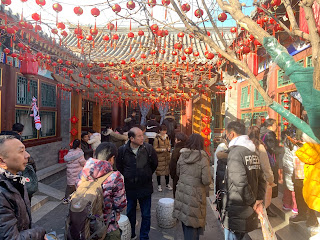Let me start today with encouragement to read the first bit of the article to the left. This is top news - the migration of people beginning the Chinese New Year. I mentioned yesterday how busy the trains were...now you see it in print!
Beijing is the capital of the People's Republic of China, the most populous country in the world and has a population of 21,500,000 people. Beijing was the seat of the Ming and Qing dynasty emperors until the establishment of the Republic of China in 1911. It is the political, educational and cultural centre of the country and as such it is rich in historical sites and important government and cultural institutions.
The city is marked by its flatness and arid climate. There are only three hills to be found in the city limits and mountains surround the capital on three sides. Like the configuration of the Forbidden City, Beijing has concentric "ring roads", which are actually rectangular, that go around the metropolis and serve as good reference points as one attempts to move about the city. Beijing was host to the 2008 Summer Olympic Games, and will also host the 2022 Winter Olympic Games, the first only city to host both these events.
This morning, following another sumptuous breakfast at our hotel, the group departed for big day of exploration beginning with Tiananmen Square and the Forbidden City.
 |
| Christine and Andrea DeGroot Nesdahl |
The centre of the city and most important landmark is Tiananmen Square. This is the world's largest public square and a must see for all visitors from abroad and from elsewhere in China. The square is surrounded by grand buildings including the Great Hall of the People, the Museum of Chinese History, the Museum of the Chinese Revolution, the Qianmen Gate and the Forbidden City. It is also home to the Chairman Mao Memorial Hall and the Monument to the People's Martyrs and was also the site of the infamous massacre of student activists by the Peoples Liberation Army in 1989.
The most important palace, bar none, is the Forbidden City. The Forbidden City was home to the Imperial Court during the Ming and Qing Dynasties. Unlike many other historical sights, the Forbidden City was relatively untouched during the cultural revolution due to the timely intervention of premier Zhou Enlai, who sent a battalion of his troops to guard the palace from the over-zealous Red Guards.
Unfortunately, your writer’s camera frizzed for a bit during the visit here so I have no great photos to show….I know your students have them, however, and I know they’ll share interior photos with you!
 |
| Lunch in Hutong home |
We left here for a visit to the Hutongs of Beijing - the original housing units of thousands of Beijingers through the years. People say that the real culture of Beijing lies in the culture of Hutong and Siheyuan (courtyards). How true it is! As such, they give an insight to the old lifestyle of ordinary Beijingers. Hutong is the name given to a narrow lane, alley, or small street between rows of single-storey Siheyuan. When viewed from the air the interlaced lanes resemble a maze or a chessboard with delicate gardens, fine rockeries and ancient ruins which makes them a wonder in the world.
We actually had lunch in one of these private homes - a highlight of our trip for many in the group! (And a first for us here in Beijing!). We got to the home by way of riding in a rickshaw (two people pulled through the narrow lanes by a bicyclist. Quite a haul for some of these guys! After lunch, we visited yet another Hutong and marveled at how an extended family shares this single living environment.
Off next to the Temple of Heaven - an imperial complex of religious buildings situated in the southeastern part of central Beijing. The complex was visited by the Emperors of the Ming and Qing dynasties for annual ceremonies of prayer to Heaven for good harvest. We also enjoyed spending time with many 60 + Beijingers who “work out” in their park. They asked us to join them in hacky-sack, badminton, stretches and all sorts of “healthy” sports!
The last stop of the day before dinner was for a “tea ceremony.” Here, students had the opportunity to learn about tea varieties, how to prepare (and drink!) it, and, for some, the chance to purchase some authentic Chinese tea to take home.
This was a BUSY, but incredible day. Today's weather was unbelievable - just over 50 degrees and sunny.









No comments:
Post a Comment